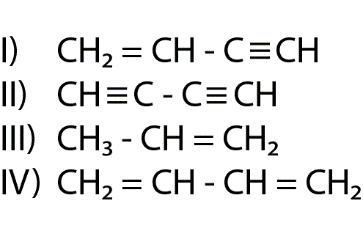
The length of carbon-carbon single bond of the compounds

is expected to increase in the order
(A) Ⅲ > Ⅱ > Ⅰ > Ⅳ
(B)Ⅰ > Ⅲ > Ⅱ > Ⅳ
(C) Ⅲ > Ⅳ > Ⅰ > Ⅱ
(D)Ⅱ > Ⅳ > Ⅰ > Ⅲ

Answer
456.9k+ views
Hint: The length of the carbon-carbon single bond depends upon the hybridization of the carbon atom. The hybridization of the carbon contains S and P characters. More will be the p percentage, more will be the length of the carbon-carbon single bond.
Complete step by step solution:
For comparing the length of the carbon-carbon single bond, we need to check the hybridization of the carbons bonded via single bonds in each option.
In
In
In
Checking each option separately,
(Ⅰ)

(Ⅱ)

Both
(Ⅲ)

(Ⅳ)

Here, both
Now, we know as the p character increases, the bond length of the carbon-carbon single bond increases.
Combining the percentage p character of the carbon-carbon single bond,
For the molecule in option (Ⅰ),
Total p percentage of carbons bonded via single bond =
(
For the molecule in option (Ⅱ),
Total p percentage of carbons bonded via single bond =
(
For the molecule in option (Ⅲ),
Total p percentage of carbons bonded via single bond =
(
For the molecule present in option (Ⅳ),
Total p percentage of carbons bonded via single bond =
(
Now, we can easily compare on the basis of combined percentage p character.
The molecule in option (Ⅲ) will have the longest carbon-carbon single bond length followed by (Ⅳ),
(Ⅰ) and (Ⅱ).
Therefore, the correct order will be Ⅲ > Ⅳ > Ⅰ > Ⅱ
So, the correct option will be option C: Ⅲ > Ⅳ > Ⅰ > Ⅱ.
Additional information:
A carbon-carbon bond is a covalent bond between two carbon atoms. Single bond is the most common form: a bond composed of two electrons, one from each of the two atoms. The carbon-carbon single bond is a sigma bond and is formed between one hybridized orbital from each of the carbon atoms.
Note:
The carbon-carbon single bond length is directly proportional to the combined percentage of p of both the carbon atoms bonded via single bond and inversely proportional to the combined percentage of s of both the carbon atoms bonded via single bond.
As the combined percentage of p increases, bond length of carbon-carbon single bond increases.
Complete step by step solution:
For comparing the length of the carbon-carbon single bond, we need to check the hybridization of the carbons bonded via single bonds in each option.
In
In
In
Checking each option separately,
(Ⅰ)

(Ⅱ)

Both
(Ⅲ)

(Ⅳ)

Here, both
Now, we know as the p character increases, the bond length of the carbon-carbon single bond increases.
Combining the percentage p character of the carbon-carbon single bond,
For the molecule in option (Ⅰ),
Total p percentage of carbons bonded via single bond =
(
For the molecule in option (Ⅱ),
Total p percentage of carbons bonded via single bond =
(
For the molecule in option (Ⅲ),
Total p percentage of carbons bonded via single bond =
(
For the molecule present in option (Ⅳ),
Total p percentage of carbons bonded via single bond =
(
Now, we can easily compare on the basis of combined percentage p character.
The molecule in option (Ⅲ) will have the longest carbon-carbon single bond length followed by (Ⅳ),
(Ⅰ) and (Ⅱ).
Therefore, the correct order will be Ⅲ > Ⅳ > Ⅰ > Ⅱ
So, the correct option will be option C: Ⅲ > Ⅳ > Ⅰ > Ⅱ.
Additional information:
A carbon-carbon bond is a covalent bond between two carbon atoms. Single bond is the most common form: a bond composed of two electrons, one from each of the two atoms. The carbon-carbon single bond is a sigma bond and is formed between one hybridized orbital from each of the carbon atoms.
Note:
The carbon-carbon single bond length is directly proportional to the combined percentage of p of both the carbon atoms bonded via single bond and inversely proportional to the combined percentage of s of both the carbon atoms bonded via single bond.
As the combined percentage of p increases, bond length of carbon-carbon single bond increases.
Recently Updated Pages
Master Class 11 Economics: Engaging Questions & Answers for Success

Master Class 11 Business Studies: Engaging Questions & Answers for Success

Master Class 11 Accountancy: Engaging Questions & Answers for Success

Master Class 11 English: Engaging Questions & Answers for Success

Master Class 11 Computer Science: Engaging Questions & Answers for Success

Master Class 11 Maths: Engaging Questions & Answers for Success

Trending doubts
State and prove Bernoullis theorem class 11 physics CBSE

1 ton equals to A 100 kg B 1000 kg C 10 kg D 10000 class 11 physics CBSE

State the laws of reflection of light

One Metric ton is equal to kg A 10000 B 1000 C 100 class 11 physics CBSE

Difference Between Prokaryotic Cells and Eukaryotic Cells

1 Quintal is equal to a 110 kg b 10 kg c 100kg d 1000 class 11 physics CBSE




